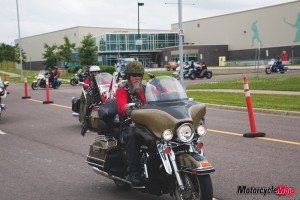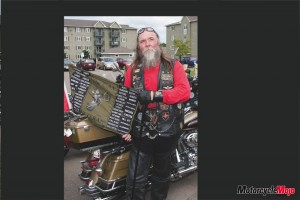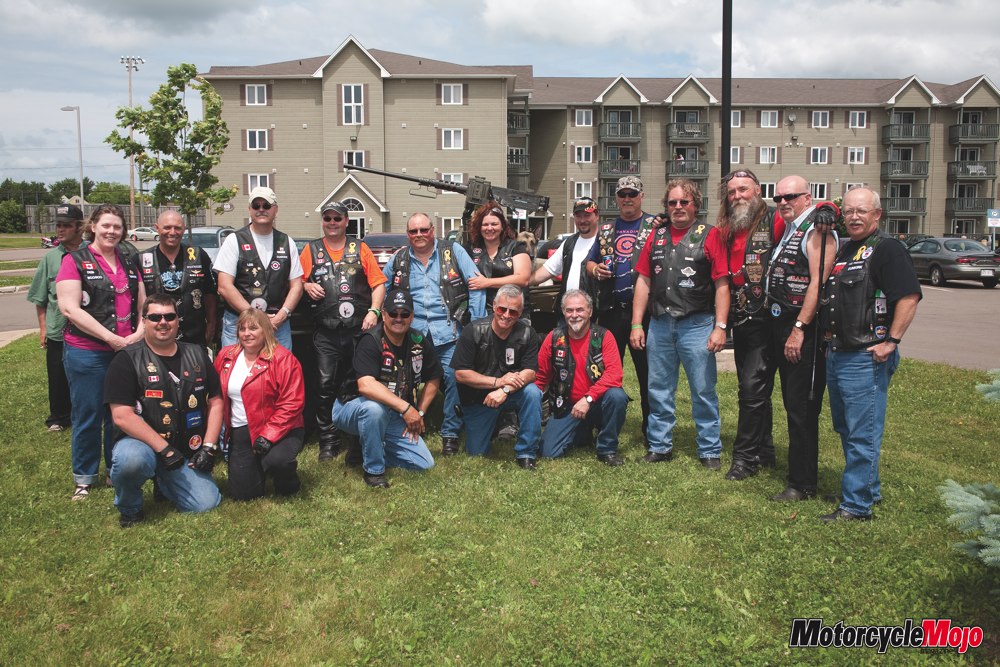If you have attended a bike show over the last few years, or participated in any charity rides, you have seen them. The crests that grace the back of their vests or riding jackets can be seen across the country as well as in other parts of the world. Most of the members have directly felt the physical and mental anguish of fighting in a theatre of war, or that of a war’s aftermath while on peacekeeping missions around the world.
The crest shows a military dispatch rider on his motorcycle, front wheel in the air, and like the knights of old, ready to leap forward into the unknown, to be the first to liberate or to help those in need. The crest is that of the Canadian Army Veteran (C.A.V.) motorcycle unit.
The C.A.V. officially began in 2003 at the first Ride for Dad rally in Kingston, Ontario. National President and co-founder Paul “Trapper” Cane said, “I saw this fellow in the parking lot at about one hundred yards and I knew by the way he carried himself that he had military training. I approached him and he was in distress. His name is ‘Doc’ Lebrun and he was from the Van Doos. He was injured in Croatia, a head injury, and he was lost; he was in need of something… somebody.” Trapper continued, “In the military they teach you to look after each other, and I had this idea for a while about a different kind of riding group. A group for veterans and those who supported them, but a different model from what generally exists.”
While Trapper has the utmost respect for other military riding clubs, he saw the need for a group that accepts civilians, including women, and all makes of motorcycles. The group’s main goal would be to help out or raise money for those in need, including integration into civilian life after the military, and much-needed support for soldiers who are returning from war and require help that the government can’t provide. Part of that help, in Trapper’s mind, is being on two wheels.
 Trapper and Doc Lebrun were the founding members as a result of that crucial meeting at the Ride for Dad, and the first two crests, from a minimum order of six, were sewn on their vests and worn proudly. Trapper had a feeling that he should have ordered more than the minimum. After the first charity ride with their crests on display, Trapper had picked up another 14 riders, and after the first month there were 267 veterans wanting crests. In the past six years, Trapper has crested over 4,000 veterans and veteran supporters into the C.A.V. in 50 units across Canada and with units in the United States, the United Kingdom and Europe. Each unit is named after a Canadian battle honour from wars gone by. There are three distinct C.A.V. formations in Canada:
Trapper and Doc Lebrun were the founding members as a result of that crucial meeting at the Ride for Dad, and the first two crests, from a minimum order of six, were sewn on their vests and worn proudly. Trapper had a feeling that he should have ordered more than the minimum. After the first charity ride with their crests on display, Trapper had picked up another 14 riders, and after the first month there were 267 veterans wanting crests. In the past six years, Trapper has crested over 4,000 veterans and veteran supporters into the C.A.V. in 50 units across Canada and with units in the United States, the United Kingdom and Europe. Each unit is named after a Canadian battle honour from wars gone by. There are three distinct C.A.V. formations in Canada:
C.A.V. 1– Central Canada (Manitoba, Ontario, Quebec);
C.A.V. 2– Eastern Canada (Newfoundland and Labrador, Nova Scotia, New Brunswick, Prince Edward Island, Baffin Island) and
C.A.V. 3– Western and Northern Canada (Saskatchewan, Alberta, British Columbia, Yukon, North West Territory, Nunavut).
Other units located outside of Canada fall under C.A.V. International. All of the units are united in outreach to the veteran while supporting their communities in charity rides and events.
The C.A.V.’s motto is “Strength and Honour” (strength to face every day, honour in doing so, in the best ways possible) and their mission statement reads “Ride, have fun, help others.” While strength and honour certainly calls to their military background, helping others may well be the big draw to the C.A.V. As Trapper said, “We are taught to look after each other.” Whether you are a fellow soldier or a civilian, the C.A.V. is there to help. In the six short years that the C.A.V. has been in existence, members have raised and donated well over six million dollars to various charities throughout the world.
The Man Behind the C.A.V.
 Trapper is a sincere, soft-spoken man with kind eyes, his hair and beard showing many years of growth. I found it hard to fathom that he was a career warrior, but his tattoos, tied together with a continuous tattoo of concertina (razor) wire, tell of the places he’s been while serving our country. His personal story is one of honour, courage and tenacity, and he knows firsthand what it means to be helped in times of need.
Trapper is a sincere, soft-spoken man with kind eyes, his hair and beard showing many years of growth. I found it hard to fathom that he was a career warrior, but his tattoos, tied together with a continuous tattoo of concertina (razor) wire, tell of the places he’s been while serving our country. His personal story is one of honour, courage and tenacity, and he knows firsthand what it means to be helped in times of need.
After six tours overseas during his 23 years of service with the PPCLI (Princess Patricia’s Canadian Light Infantry), he had a devastating career-ending accident while in the line of duty. He was in a mid-air collision with another soldier who had blacked-out, and their chutes tangled, resulting in both of them freefalling, Trapper below the other soldier. Just as they are trained to jump on a live grenade in order to save their comrades, Trapper reached for his knife to cut his own parachute ropes, sealing his fate but hopefully allowing the other jumper to survive. “At around 200 feet, the other soldier’s chute opened, and it was like he stopped in mid-air while I continued to fall. I deployed my reserve chute but it takes more than two hundred feet to open, so while it may have slowed me down a bit, I hit the ground,” Trapper said.
Trapper shattered all of his teeth, broke his spine in three places (amongst plenty of other spinal damage), shattered his right hip and pushed his femur into his bowel. And that was just the big stuff–no need to mention that his whole body was pretty much broken. He jokes, “luckily I landed on my head or I could have been seriously hurt.” Two years (most of that paralyzed) and 18 operations gave Trapper lots of time to think…about motorcycles. He was told he would never walk again and, therefore, never ride again. He had been riding since the early seventies and throughout his military career, either renting or borrowing bikes wherever he was posted. He didn’t think something like a completely broken body would stop him from riding. Through all the horrible things he had experienced during his military career, riding motorcycles was his therapy; having that fresh air rush past his head seemed to clear the horrors of war.
Only when he was able to shimmy from his bed into a wheelchair did he receive his first pass from the hospital. After two long years and possibly too much thinking, but never giving up, Trapper was ready for a change. Out of sight of the prying eyes of nurses and doctors, a couple of civilian friends had brought Trapper’s bike to the hospital. With some help, Trapper inched his way onto the seat and with crutches bungeed onto the bike, he rode away, leaving the wheelchair behind.
From Ottawa, he made it to Pennsylvania the first day, and after two days’ rest, he rode to Florida. His legs still not working, he had hotel staff help him to the room. Never one to give up, Trapper thought that if he could ride, he could walk. Eventually he returned for rehabilitation to begin the arduous journey of learning to walk all over again.
“Two wheels, the fresh air and literally leaving your troubles behind. The motorcycle is a device to propel you into the future,” Trapper said. That statement sums up why the motorcycle is such an important part of the C.A.V.
Beneficiaries of the C.A.V.
Trapper learned early on that every bit helps; even what seems like a drop in the bucket can change a life. “There was this little guy with no safety valve; his brain couldn’t tell him what was dangerous. The parents needed a guide dog to lead him around and keep him out of harm’s way. The cost of the dog was $18,000. We decided to raise money to help cover that cost, so about thirty C.A.V. members went for a ride and we raised some money for the family.” Trapper continued, “We only raised $1,000, and when I handed it over the mother broke down crying, she lost it. I apologized (for the small amount) and she said, ‘You don’t understand. With the help of the Lions Club, our savings and our line of credit, we were able to reach $17,000. Your $1,000 put us over the top.'”
Since those early days, lessons have been learned. More members fundraising has made the organization more efficient, to the point where the C.A.V. raises hundreds of thousands of dollars yearly for those who need it most.
The Tony Stacey Centre for Veterans Care is one of the ongoing beneficiaries of C.A.V. funds. Our society places veterans in government-funded long-term care facilities, alone, while their spouse has to live outside the facility. The privately funded not-for-profit Tony Stacey Centre allows spouses to stay together in their golden years, making their remaining time less traumatic. “In some cases these people have been together since the 40s and then they are split up to deal with health issues, Alzheimer’s and dementia–alone. These veterans live longer, more comfortable lives when they can stay together.” Trapper concluded, “Our last ride in Toronto raised $17,000 for the Tony Stacey Centre. Their roof is leaking, so the money will be put to good use. It was a great honour for us to help out.”
The C.A.V. has donated over $10,000 to Fisher House in Landsthul, Germany, so the families of our wounded soldiers can stay by their bedsides while they recover. They also raise funds for the world’s poorest people through ICROSS (International Community for the Relief Of Starvation and Suffering). Just recently, money went toward the purchase of a blood analysis machine and an X-ray machine for Africa, and on the slate next are feeding facilities and renewed vision for the poor and near-blind of Madagascar.
These are just a few mentions of the great work these men and women do, both locally and abroad. During 2009, CAV units helped 311 charities, and on any given weekend there are 10 to 30 units doing something to help a charity of some kind.


















